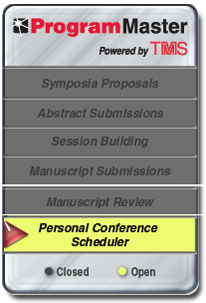

|
TMS 2013 142nd ANNUAL MEETING & EXHIBITION
MARCH 3-7, 2013 • Henry B. Gonzalez Convention Center, San Antonio, Texas
 Magnesium Technology 2013 Plenary Session
Magnesium Technology 2013 Plenary Session
By Graduate Student Reporter Graham Sanborn, Georgia Tech
Posted on:
Mar 5 2013
The TMS conference kicked off the week with a special plenary session at the Magnesium Technology 2013 symposium. On Monday morning, six presenters spoke about topics ranging from magnesium (Mg) grain refinement technology to testing their corrosion resistance and phase transformations. At the beginning of the session, four best paper awards from the 2012 proceedings were given in the topics of application, fundamental, poster, and student.
Karl Kainer from the Helmholtz-Zentrum Geesthacht started the morning with a review of Mg alloys in the 21st century. Kainer started by discussing Elektron, the first patented Mg-based alloys, and the International Magnesium Association (IMA). From here, he detailed the process development of high-purity alloys. Examples covered the engine and transmission housings used in the first VW Beetle to the high-temperature-resistant Mg materials used for today's automobiles.
An invited talk by David StJohn of the University of Queensland discussed the history of grain refinement technology in cast Mg alloys. This talk started with the first work on grain refinement in the 1930s and zirconium addition to induce grain refinement. StJohn introduced the Interdependance Theory as a theoretical framework to understand the mechanism of grain refinement and the role of solutes. He also spoke about the importance of Mg-Zr master alloys and the current developments of Mg-Al commercial implementation.
Joy Forsmark, Ford Motor Company, gave a talk about the United States Automotive Materials Partnership (USAMP) magnesium front end research and development project. This project is a collaborative partnership between Ford, GM, Chevrolet, and the U.S. government to develop and advance Mg front-end structures in automotive parts. Specifically, Forsmark reviewed results from phase 1 of the project, which set out to develop and test a Mg "demonstration" structure. The design study found that the use of Mg parts could result in a 45% weight reduction and 60% part consolidation in unibody designs, and could result in a 25% weight savings in body-on-frame designs.
The next talk focused on AC-DC-AC testing methods to assess corrosion resistance of polymer coatings in Mg alloys. This talk was given by Robert C. McCune, Robert C. McCune & Associates LLC, and focused on the automotive Mg parts discussed in the previous talk. McCune discussed how the automotive industry could use better characterization methods, and presented results from the AC-DC-AC and impedance spectroscopy testing methods.
Rainer Schmid-Fetzer of the Clausthal University of Technology presented on the thermodynamics of phase transformations in Mg-La-Ce-Nd alloys for new material development in the industry. He spoke about the need for better experimental data and the formation of complex intermetallic solid solutions in these systems.
The last talk of the morning was presented by Yoshihito Kawamura from Kumamoto University on current developments of high strength and non-flammable Mg alloys. He discussed a new high strength, non-flammable, and corrosion resistant alloy that could make Mg production more cost effective and safe.
Norbert Hort of the Helmholtz-Zentrum Geesthacht Centre for Materials and Coastal Research served as the session moderator.
|